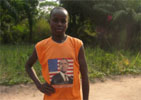
President Obama’s strategy to help stop violence perpetrated by the LRA provides a broad blueprint for action. For that blueprint to become a legitimate path to peace, the administration must take immediate steps to put it into action. We’re partnering with our friends at Resolve to outline six steps the administration should take to kick-start implementation of the strategy (read our posts on Step 1, 2, 3, and 4). Ultimately, the success of the strategy will be judged by whether it actually keeps people in central Africa safe from LRA attacks, but by taking these six steps President Obama can demonstrate he is serious about achieving that goal.
Item 5: Ensure rapid progress on priority actions listed in the strategy
President Obama outlines several “priority actions” for implementing his LRA strategy, including increasing access to remote communities by building roads and telecommunication infrastructures, augmenting mobility for those trying to protect communities targeted by the LRA, enhancing coordination of information-sharing among the troops and agencies involved in the region, and increasing the opportunities for defections of LRA commanders and abductees.
These are great ideas, but they need to be put into action without further delay. Building radio and mobile phone networks in remote areas of Congo and Central African Republic is an especially urgent priority. The LRA targets communities that lack passable roads, access to electricity and functioning radio, and mobile phone networks. Military forces often do not respond to LRA attacks in these disconnected communities and attacks in these areas can go unreported to national authorities and international media for months, leaving survivors stranded and victims uncounted.
The U.S. international development agency, USAID, has done assessments on how to begin the process of better connecting these remote communities to telecommunications networks, but it’s time to start constructing roads and cell and radio towers and linking them with community-driven early warning systems. Every day without progress means another day in which entire communities are disconnected and more vulnerable to LRA attacks.
President Obama’s strategy is right; he doesn’t have to go it alone. He can work with international partners to unroll these priority actions on the ground, including expanding the mobility of civilian protection forces. U.S. Ambassador to the U.N. Susan Rice should work through the Security Council to ensure that U.N. peacekeepers in Congo and South Sudan have additional helicopters and resources needed to protect civilians in remote rural areas. The Security Council also needs to direct these peacekeepers to make protecting civilians from LRA violence more of a priority, including by sending more peacekeepers to areas affected by the LRA.
President Obama can help fund and facilitate local and international civil society groups (check out what our friends at Invisible Children are doing) that are encouraging defections among commanders and abductees by building rehabilitation centers and helping defectors find their way home. He should keep attention on the progress that is being made by those inside and outside of government and maintain a focus on the ways each of these actors can take immediate steps to ensure communities in central Africa feel safe instead of scared.

